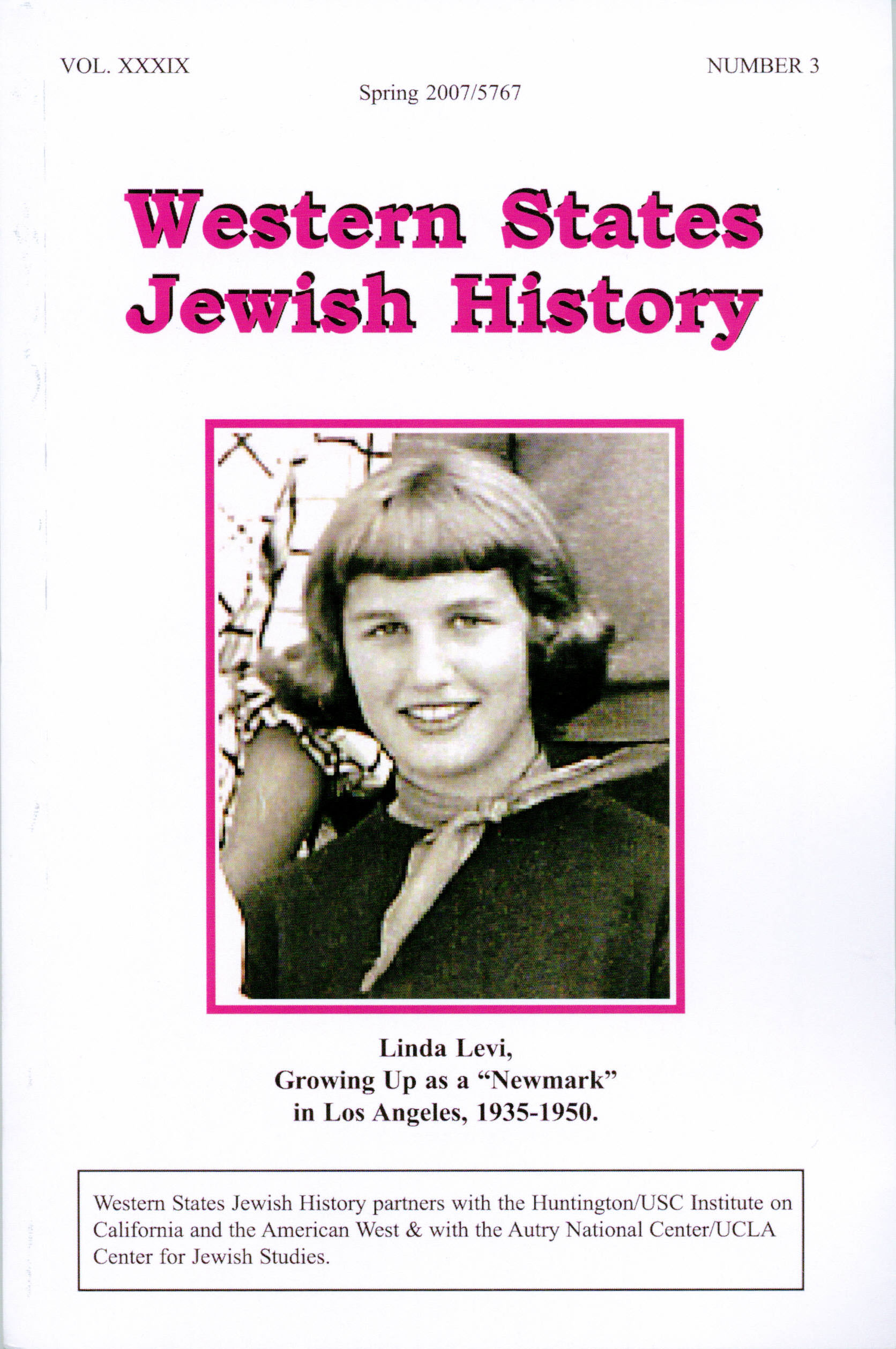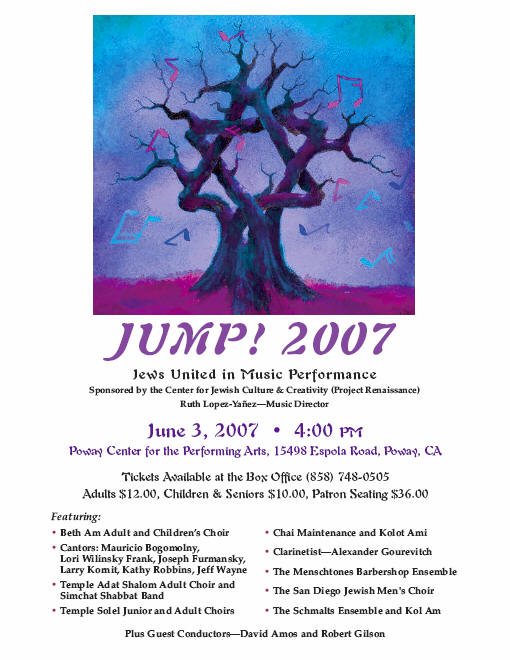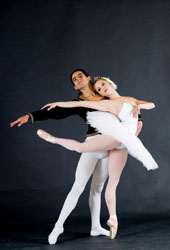Louis Rose Society Newsletter No. 6
Wednesday, April
4, 2007
-------------------------------------------------------------------------------------------------------------------------------------------------------------------------------
In this issue:
Unleavened Bread and 'Boiled News'
Tchaikovsky Salute at JCC
Music to Make You Jump June 3
Gert Thaler Tribute Dinner
Jewish Community Calendar
Unleavened Bread and 'Boiled News'
in Western States Jewish History
 Editor's
Note: An unusual article in the current Spring
2007 issue of Western States Jewish History, a quarterly, concerns some of
the "boiler plate" stories that Jewish newspapers printed during the 19th
century. These were stories that were pre-set in type, ready to fill
any hole in the newspaper when there was insufficient news to take up the
whole edition. They often were written with the purpose of explaining
Judaism to Christians who might pick up the Jewish newspapers
Editor's
Note: An unusual article in the current Spring
2007 issue of Western States Jewish History, a quarterly, concerns some of
the "boiler plate" stories that Jewish newspapers printed during the 19th
century. These were stories that were pre-set in type, ready to fill
any hole in the newspaper when there was insufficient news to take up the
whole edition. They often were written with the purpose of explaining
Judaism to Christians who might pick up the Jewish newspapers
One of the "boiler plate" stories brought back by the quarterly history
magazine had been printed on March 2, 1891 by the Bridgeport (Mono County,
California) Chronicle-Union. With thanks to WSJH, we reprint it below.
Four more "boiler plate" stories may be found in the quarterly, as well as
feature stories on synagogues in Texas, Cantor Reuben Rinder of San
Francisco, and Linda Levi's reminiscence about "Growing Up as a 'Newmark' in
Los Angeles, 1935-1950."
Unleavened BREAD:
Hebrew Bakers ARe Three MOnths
Preparing for passover
Over three thousand years ago the Israelites made their exodus from bondage
under Egyptian rulers, and ever since that time the week following the
fifteenth day of the first Hebrew month, the month of Nissan, has been set
aside for commemoration of their departure. It was on the night of the
fourteenth of Nissan that the Hebrews, now numbering three million, were led
to freedom by Moses. In Chapters twelve and thirteen of Genesis the
manner of celebration on the first night of the feat is partly told, and
there it is commanded that unleavened bread be eaten on the first night ad
no loaves be kept in the house at any time during the week. This is in
remembrance of the fact that the Jews in their hurry to leave Egypt were
forced to take along unleavened bread, which they had to bake in the sun. A
great many Israelites have a separate set of dishes to be used once a year
during this week only, and those who have not an extra set of dishes scour
out their dishes thoroughly. In Europe, when they happen to have any
bread or other sort of leaven in the house the housewife locks the pantry
and hands over the key to some old Christian friend of hers to keep till the
feast is over.
The making of these unleavened cakes called matzos has come to be quite an
industry in this country, says the Times-Star of Cincinnati. For three
months before the feast of Passover the matzos bakers are busy, and nearly
eight million matzos are baked in this city from the middle of January to
the middle of April. This represents about four hundred and forty-five
thousand dollars.
Said the head baker at a large bakery: "We make about eight thousand matzos
a day, for which we use four barrels of flour."
"Do you use the ordinary flour?"
"Yes, but it is the finest quality, and has to be examined by a Hebrew, who
judges whether it is satisfactory. We buy ours in this city. Then the
water used must be put into a vessel before sundown and remain to settle for
the whole night. This bakery is for baking unleavened bread only, and every
thing is especially got for this bakery, even to the rags we use."
"How do you prepare the flour?"
"We take, say, fifteen pounds of flour, and, mixing it with water, we put it
into a copper kettle, where it is thoroughly mixed. Then this man, the
kneader, takes it, and on this block by means of pressing on this heavy
beam, he kneads the dough to the proper cohesiveness." The reporter saw a
block, on top of which was a beam four feet long, fastened by a spring at
the back of the block; and there was a man jumping on and off the beam, so
as to make a sot of artificial kneader, the beam rising when the man jumped
off.
"It is then taken to the next room," said the baker, "and about a third of
it at a time is passed seven times through these rollers, which, you see,
are arranged like a clothes-ringer's rollers, only these are iron.
Having been so pressed, it is of the proper thickness. Care has to be taken
here that while one piece of dough is being pressed the other pieces should
not become too hard; therefore a man is continually beating them. The piece
of dough, now a strip ten inches wide by ten feet long, is put under the
hands of a man who uses a roller much like the ordinary dough roller, except
that these are sharp projections sticking out all around to make little
holes in the cakes. Next to him is a man with a sharpened wheel which he
uses to cut the strip into pieces, each the length of a cake. These pieces
are put into an over, and in two minutes they are done."
And the gentleman handed the reporter a matzo, which was almost tasteless
except for the slight browning it had acquired."
"Are these cakes made the same way in Europe?"
"No, abroad there is more hard work. Women knead the dough by hand, and the
cakes are thicker than we make them here. Matzos cost about ten cents
a pound, and the meal which we make by grinding broken matzos costs eleven
cents a pound. We make one hundred pounds of meal a day."
Western States Jewish Quarterly has announced the opening of its new
website, www.WSJHistory.com.
Advertisement:
. Join
us.ening honoring a pioneer of San Diego’s Jewish
Join
us.ening honoring a pioneer of San Diego’s Jewish
Advertisement:

City Ballet Impresses in Tchaikovsky
Salute at Lawrence Family JCC
By Sheila
Orysiek
Dance Writer
LA JOLLA—City Ballet is well past the
point of being a pleasant surprise – it has reached the level of
consistently presenting an evening of sustained professional dance. The
usual collection of small telltale ragged edges: loose ribbons, unsettled
head pieces, wiggly lines, errant hands and heads, coming out of character
before fully out of sight, which infests amateur dance, the pitfalls which
distract the viewer, are not anywhere to be found in this group. By any
measure this is a “company” performance, not a school recital or a
collection of dancers who happen to come together. Each artist has been
carefully chosen, the program well thought out, culminating in a happy
outcome. This is a result of a steady hand guiding, teaching, coaching and
presenting an entirely worthwhile ballet experience. The contract of worthy
dance for ticket purchased is definitely fulfilled – one does not feel
cheated An oasis of a true evening of classical dance in a city otherwise
too often a desert.
Performing Swan Lake Act ll, with
only a dark backcloth of a minimalist lake-ish scene, the dancers are at the
mercy of an ancient iconic ballet that demands style and standard. The
result of careful rehearsal and coaching was consistently evident during
performances last weekend in the Garfield Theatre of the Lawrence Family
Jewish Community Center. Every head, every arm of the swans was precisely
placed and the importance of this transcends the moment since a classically
based ballet company is ultimately judged by the caliber of the corps de
ballet. Arabesque legs in the voyagé passage throughout the
groupings of swans were aligned in height and solidly held. All too often,
because of the difficulty involved, a ragged edge shows up in flopping legs,
but not for this company. A careful directing eye had seen to that.
Occasionally a not quite fully stretched
foot in a very quick sauté, or a shallow pas de chat amongst
the four cygnets proved to be the rare exception – and was noticed because
it was an exception. When the three big swans, Megan Coatney, Tara Formanek,
and Alexis Risi, flashed across the stage with absolutely synchronized,
fully split grand jetés, any major company would have been proud.
 Ariana
Samuelsson and Ivan Bielik were a noteworthy Odette and Siegfried. She’s a
Queen protecting her flock rather than a melting fragile Odette. Clear
rounded mime was not ignored but was given as a natural accompaniment to the
dance, not separate from it – as is sadly seen too often these days. With
beautifully undulating arms (although taken a bit lower were almost a la
Plisetskaya), Samuelsson never wavered in her portrayal of the progression
from swan to almost woman and back to swan as intrinsic rather than
assumed. Bielik is
Ariana
Samuelsson and Ivan Bielik were a noteworthy Odette and Siegfried. She’s a
Queen protecting her flock rather than a melting fragile Odette. Clear
rounded mime was not ignored but was given as a natural accompaniment to the
dance, not separate from it – as is sadly seen too often these days. With
beautifully undulating arms (although taken a bit lower were almost a la
Plisetskaya), Samuelsson never wavered in her portrayal of the progression
from swan to almost woman and back to swan as intrinsic rather than
assumed. Bielik is
(c) Dale Stokes
blessed with long clean lines and he is an admirable, strong partner. There
is not much dancing for Siegfried in this act and I longed to see him do
more.
The Black Swan Pas de Deux danced by Janica Smith and Gerardo Gil,
was presented without any stage set or back cloth. It left the dancers
completely at the mercy of an exacting choreography and it is to their
credit that none of the theatrical niceties were needed. Gil is a compact
dancer, careful partner and exudes energy. It was interesting to see that
in one of his multiple pirouettes his axis began to tip, but he remained
unrattled, even throwing in an extra rotation, fixed the “problem” while
turning, and ended cleanly. Shows a maturity of “situation.” Smith began
the (in)famous fouettés up stage, traveled them down the diagonal,
stopped traveling when she came to center stage, and continued on turning,
every fourth one a double. It was an admirable performance from both
dancers.
Tchai Celebration,
a world premiere, choreographed by Elizabeth Wistrich, to twelve
orchestrated piano pieces “The Seasons, Opus 37B, representing months of the
year, was the highlight of the evening. The company is truly blessed to
have this resident choreographer. Her composition is always sourced in the
music, never obviously fabricated, isn’t bogged down with invention for
invention sake and yet always inventive. She doesn’t choreograph for her
own ego, but for the dancers; this is her gift to them. And they relish it
– responding with energy and appreciation. Choreographer and dancers fit
together like a hand in a glove, and together explore space and music.
The “June” pas de deux for Ariana
Samuelsson and Ivan Bielik, was as beautiful as any I’ve seen – on any
stage. Avoiding the pitfall of the “let’s see how many ways we can stretch
and bend her” school-of-choreography, or the grappling that passes for
passion all too often seen in all too many “dances for two” – this pas de
deux flowed from one eye happy confluence of line and curve to another.
Complex, but never strident or falsely contrived, lifts, a toss, a catch,
were so smooth they weren’t “tosses and catches” at all, but arose naturally
– as if all of us could respond to music that way. Wistrich makes ballet
look natural, like movement was meant to be, rather than a way of moving
that takes so many years to accomplish.
Janica Smith and Gerardo Gil’s “October”
was also beautifully done. A particularly charming dance and dancer was
Megan Coatney in “November.” Dressed in bright red, she was saucy and
engaging. Though choreographed as a solo, it was also a port de bras pas
de deux; her hands and arms in a whimsical language of their own.
Throughout the twelve pieces of varying
numbers – solos, twosomes, threesomes or as a stage filled with dancers, the
costuming ran the gamut from unitards and tunics, swirls of flowing skirts,
from casual clothes to tutus. The colors overall were pleasant pastels,
Coatney’s bright red the exception and it highlighted her particular charm.
The finalé brought together five couples in black and gold classical tutus
and jackets that filled the stage with dancing and finishing with panache.
It seems that San Diego finally has a
ballet entity that has left behind any semblance to pre-professional dance
status. One can only hope that the citizens of this area will recognize the
opportunity and enjoy this gift of a company.
All the music was taped and aurally
comfortable, for which this reviewer is grateful.
This review also appears in the current issue of Ballet.co.uk Magazine
_________________________________________________________________

